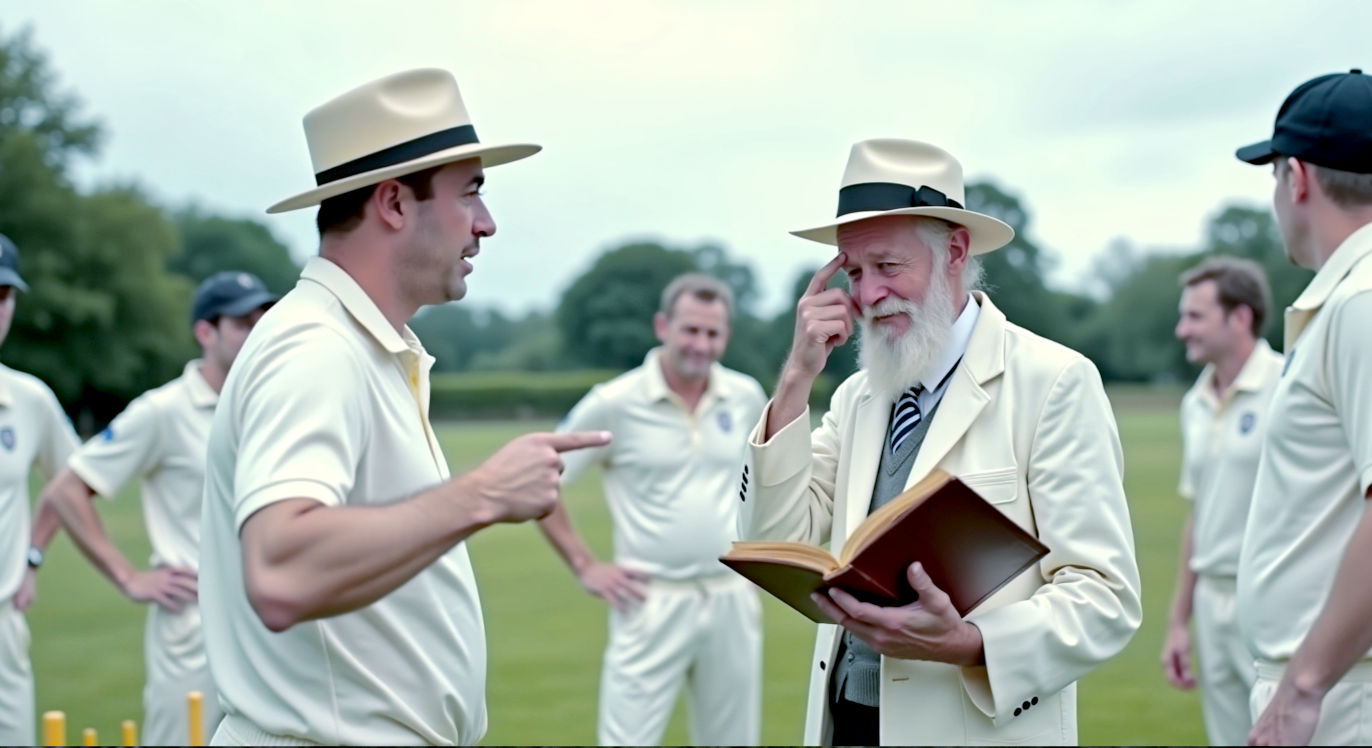Goggles, Dropped Bats, and One-Point Safety Kicks: A Deep Dive into the Strangest Rules in Sport
An in-depth look at the most bizarre rules in professional sports, from football’s back-pass rule to cricket’s “Timed Out” law, exploring their quirky origins and lasting impact.

This post may contain affiliate links. If you make a purchase through these links, we may earn a commission at no additional cost to you.
Picture this: it’s the final, heart-pounding moments of a crucial match. A player makes a brilliant, game-changing move, only for the referee to blow the whistle. The crowd falls silent, confused. The commentator fumbles for words. It turns out, a rule—an obscure, almost forgotten rule—has just turned the game on its head. Welcome to the weird and wonderful world of professional sport, where some regulations seem less like strategic guidelines and more like historical quirks that refuse to fade away.
From football’s oddities to cricket’s head-scratching laws, sports are littered with rules so bizarre they sound like they were made up over a pint down the local pub. But these aren’t just silly footnotes; they’re real, enforceable regulations that can decide championships, end careers, and leave fans utterly bewildered. They’re the hidden tripwires and secret passages of the games we love, often born from moments of chaos, controversy, or pure, unadulterated fluke.
So, grab your cuppa, settle in, and let’s take a journey through the looking glass. We’re about to explore the most baffling, hilarious, and downright bonkers rules that govern the world of professional sport. You’ll never watch a match the same way again.
Why Do Bizarre Rules Even Exist? The Method Behind the Madness
Before we dive into the strangest regulations themselves, it’s worth asking: how did we get here? Strange rules don’t just appear out of thin air. They’re usually the result of a very specific, often chaotic, event that forced the rule-makers to act. Think of it like this: every bizarre rule is a scar from a past battle.
The Knee-Jerk Reaction: Closing Loopholes
Many of the weirdest rules were created to stop clever (or downright unsporting) players from exploiting a loophole. Someone, somewhere, did something so outrageous and unexpected that the governing body had to step in and say, “Right, you can’t do that anymore.”
A classic example comes from basketball. In the early days, players realised they could just hold the ball indefinitely to run down the clock. There was no rule against it. This led to dreadfully boring games where the leading team would simply pass the ball around for the last few minutes. To fix this, the 24-second shot clock was introduced in 1954. It seemed a bit strange at first—forcing a team to shoot within a set time—but it revolutionised the sport, making it faster and more exciting.
Health and Safety Gone Mad? Protecting the Players
Other rules, which might seem silly on the surface, are actually there for a very good reason: to keep the athletes safe. Sport is a dangerous business, and governing bodies have a duty to protect their players, even if the solutions look a bit odd.
Take the “HANS device” in Formula 1 racing. It’s a head and neck support system that looks like a cumbersome collar. When it was first introduced, some drivers complained it was restrictive and awkward. But it was brought in after a series of tragic accidents and has since been credited with saving countless lives by preventing severe head and neck injuries during crashes. It’s a perfect example of a rule that might look strange but is absolutely essential.
Preserving the “Spirit of the Game”
Finally, some rules exist to uphold a sport’s core values and traditions. These are often the hardest to explain because they’re less about logic and more about emotion and history. They’re there to ensure the game is played in the “right way.”
Cricket is full of these. The unwritten rule about “Mankading” (where a bowler runs out the non-striking batsman before bowling the ball) is a great example. It’s perfectly legal within the laws of the game, but many players and fans consider it unsporting. It goes against the “spirit of cricket,” a concept that’s almost as important as the official rulebook itself. These are the rules that spark the fiercest debates because they’re about honour and fair play, not just points on a scoreboard.
So, as we explore some of the world’s most bizarre sports rules, remember that each one has a story. It’s a tale of innovation, desperation, or a heartfelt attempt to keep the game we love pure.
Football’s Head-Scratchers: More Than Just Offside
Football, the beautiful game, is meant to be simple. But dig a little deeper, and you’ll find a rulebook with some truly peculiar clauses. These are the ones that can leave even the most seasoned fans scratching their heads.
The Back-Pass Rule: A Goalkeeper’s Nightmare
For decades, football could be a painfully dull affair. A team in the lead could simply pass the ball back to their goalkeeper, who would pick it up, hold it for a bit, and then roll it out. It was a perfectly legal, but soul-destroyingly boring, way to waste time. The 1990 World Cup was so full of this tactic that fans were booing teams off the pitch.
FIFA knew something had to change. So, in 1992, they introduced the back-pass rule. It states that if a player deliberately kicks the ball to their own goalkeeper, the keeper is not allowed to handle it. They have to use their feet, just like any other player on the pitch.
At the time, it caused chaos. Goalkeepers who were used to being confident custodians were suddenly forced to become outfield players, often with disastrous results. Shaky first touches, panicked clearances, and comical own goals became common. But it worked. The rule change made the game faster, more exciting, and forced teams to play more attacking football. It might have seemed bizarre at first, but it saved the game from itself.
The Two-Person Kick-Off: A Relic of the Past
Here’s a rule so ingrained in football culture that many people didn’t even realise it had changed. For over a century, a kick-off required two players. One would nudge the ball forward, and the other would then be free to pass it. The ball had to move forward into the opponent’s half.
But why? The rule was a leftover from the game’s Victorian origins, where the idea was to kick the ball towards the opposition to start the game. It was a tradition nobody questioned.
Then, in 2016, the rule was quietly changed. Now, only one player is needed for the kick-off, and they can pass the ball in any direction—backwards, sideways, wherever they like. It was a small change, but it symbolised football’s move into the modern era. You’ll still see older fans and Sunday league players instinctively setting up for a two-person kick-off, a nostalgic echo of a rule that has long since vanished.
The One-Point Safety: The Rarest Score in American Football
While we’re on the subject of football, let’s hop across the pond to its American cousin, a sport known for its complex and sometimes bewildering rules. Most fans know the scoring: six points for a touchdown, three for a field goal, two for a safety. But what about a one-point score?
Yes, it exists. It’s called a one-point safety, and it’s so rare that it has never happened in the entire history of the NFL. It’s the unicorn of football scores.
Here’s how it can happen. After a touchdown, a team attempts a conversion (either a one-point kick or a two-point play from scrimmage). Imagine Team A scores a touchdown and lines up for a one-point kick. But the kick is blocked, and the ball is recovered by Team B. A player from Team B then runs with the ball all the way back towards his own end zone but is tackled in his own end zone.
In this incredibly specific, almost impossible scenario, Team A—the team that was originally attempting the kick—is awarded one point. It’s a safety, but because it happened during a conversion attempt, it’s only worth one point. It’s a perfect example of a rule that covers such a bizarre and unlikely situation that it exists almost purely in theory. It’s the ultimate pub quiz question for any sports fan.
Cricket’s Curious Laws: It’s Just Not Cricket
If you think football has some odd rules, you haven’t met cricket. It’s a sport governed by a set of “Laws,” not rules, and some of them are so wonderfully strange they could only have been invented by the English.
Timed Out: Don’t Be Late to the Crease
In most sports, a bit of tardiness might get you a fine or a telling-off from the gaffer. In cricket, it can get you out without ever facing a ball. Law 40 of cricket is the “Timed Out” rule.
It states that an incoming batsman must be ready to face a ball (or have their partner ready) within three minutes of the previous wicket falling. If they’re not, the fielding team can appeal, and the umpire has no choice but to give them out.
This isn’t just a theoretical rule. It has happened in professional first-class cricket. In 2002, Indian batsman Hemulal Yadav was given out timed out in a match because he was busy chatting with his team manager and didn’t realise it was his turn to bat. He was still in the pavilion when the appeal was made. It’s the ultimate cricketing walk of shame: dismissed for bad timekeeping.
Handling the Ball: A Rule for the Overly Eager
Imagine a batsman has just played a defensive shot. The ball dribbles to a halt just in front of the stumps. The batsman, being a helpful sort, picks up the ball and throws it back to the bowler. A nice gesture, right?
Wrong. In cricket, that’s “Handling the Ball,” and it’s another way to get out. A batsman is not allowed to touch the ball with their hands while it’s live, unless they have the permission of the fielding side. The rule is there to prevent a batsman from illegally obstructing the field, for example, by knocking the ball away from a fielder trying to catch it.
It’s a rule that often catches out players acting on instinct. In a 2001 Test match, England’s captain Michael Vaughan instinctively swatted away a ball that had bounced back towards his stumps. The Indian team appealed, and Vaughan was given out. He wasn’t cheating; he was just trying to protect his wicket. But the Laws of Cricket are unforgiving.
The Duckworth-Lewis-Stern Method: Rain, Rain, Go Away
Perhaps the most famously confusing rule in all of sport is cricket’s method for deciding rain-affected matches: the Duckworth-Lewis-Stern (DLS) method. When rain stops play in a one-day match, and overs are lost, you can’t just have a draw. A winner must be decided.
This is where DLS comes in. It’s a complex mathematical formula that calculates a revised target for the team batting second. It takes into account how many overs have been lost and how many wickets the batting team has remaining. The core idea is that a team with 10 wickets in hand has more scoring potential than a team with only two wickets left.
To the average fan, DLS is completely baffling. It often produces targets that seem unfair or illogical. A team might need 50 runs from 5 overs, but after a rain delay, the target suddenly becomes 20 runs from 2 overs. Commentators spend ages trying to explain the calculations, often with the help of a dedicated statistician. It’s a necessary evil in a sport that’s so often at the mercy of the British weather, but that doesn’t make it any less bizarre.
From the Court to the Track: Weird Rules in Other Sports
The strangeness doesn’t stop with football and cricket. Almost every sport has a rule lurking in its books that makes you do a double-take.
Basketball: The Illegal Defence of Yesteryear
For a long time, the NBA had a rule called the “illegal defence.” It was designed to promote one-on-one matchups and stop teams from simply clogging up the area around the basket (known as the key). In simple terms, a defender wasn’t allowed to stand in the key for more than three seconds unless they were actively guarding a specific player.
This meant teams couldn’t play a “zone defence,” a common tactic in international basketball where defenders guard an area rather than a player. The rule was meant to showcase the incredible individual talents of stars like Michael Jordan, allowing them to drive to the basket without facing a wall of defenders.
But it made the NBA different from every other basketball league in the world. It was confusing for fans and players alike. Finally, in 2001, the NBA scrapped the illegal defence rule and allowed zone defences. The game didn’t fall apart. In fact, it forced teams to be more creative with their attacking strategies.
Swimming: The Goggle Controversy
You might think swimming is a simple sport. Get from one end of the pool to the other as fast as you can. What could be controversial about that?
Well, what if your goggles fall off? In a bizarre and heartbreaking incident at the 2008 Beijing Olympics, American swimmer Michael Phelps faced this exact problem. During the 200-metre butterfly final, his goggles filled with water on the first lap. He was effectively blind.
According to the rules, he couldn’t stop to fix them. A swimmer can be disqualified for stopping or for not touching the wall with both hands simultaneously in butterfly. Phelps had no choice but to carry on. He counted his strokes, trying to guess where the wall was. Incredibly, he not only finished the race but also won the gold medal and set a new world record. It was a heroic performance, but it highlighted a strange rule: in a sport where vision is crucial, a tiny equipment malfunction can ruin a race with no chance of recovery.
Formula 1: The Perils of Reverse Gear
Formula 1 cars are technological marvels, capable of incredible speeds. They also have a reverse gear, just like a normal road car. But using it is a very risky business.
The F1 rulebook states that a driver is not allowed to drive their car in reverse in the pit lane unless it’s to move out of their pit box. On the track itself, reversing is almost completely forbidden. If a driver spins and ends up facing the wrong way, they can’t just pop it in reverse and sort themselves out.
The rule is there for safety, of course. A car reversing on a live racetrack would be incredibly dangerous. But it has led to some strange situations. Drivers have been disqualified for receiving help from marshals to get their car pointing the right way. In one famous incident, Nigel Mansell was disqualified from the 1989 Portuguese Grand Prix for reversing in the pit lane after he overshot his pit box. It cost him the race and showed that even the most basic driving manoeuvre is fraught with danger in the high-stakes world of F1.
The Enduring Appeal of the Bizarre
So, what do all these strange rules tell us about sport? They show that games are not perfect, static things. They are constantly evolving, adapting to new strategies, new technologies, and new moments of madness. A bizarre rule is a living piece of history, a reminder of a time when a goalkeeper could pick up a back-pass, or a batsman could be out for being a bit slow.
They also add a layer of wonderful unpredictability to the games we love. They are the curveballs, the wild cards that can turn a predictable match into a chaotic, unforgettable spectacle. They spark debates in pubs and on television, creating the kind of drama that keeps us coming back for more.
In a world where sport is becoming ever more professional and scientific, these weird rules are a comforting reminder of its human, and often very silly, origins. They are the ghosts in the machine, the quirks in the code that make sport more than just a game. They make it a story. And who doesn’t love a good story?
Further Reading
For those eager to delve deeper into the intricacies of sporting regulations, these resources offer authoritative and comprehensive information:
- The FA Handbook: The official rulebook for English football. https://www.thefa.com/football-rules-governance/lawsandrules/laws/football-11-11/law-1—the-field-of-play
- The Laws of Cricket (MCC): The definitive guide to the laws of cricket, governed by the Marylebone Cricket Club. https://www.lords.org/mcc/the-laws-of-cricket
- Official NFL Rulebook: The complete and official rules of the National Football League. https://operations.nfl.com/the-rules/nfl-rulebook/
- Formula 1 Sporting Regulations: The official regulations that govern F1 racing. https://www.fia.com/regulation/category/110






